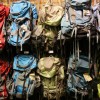Land Border Crossing Checklist
| by Jason | 5 Comments » | Travel Tips
With ten land border crossings under our belt, it’s time to share our experienced check list. Our first land border crossing was from Guatemala to El Salvador and it involved a boat ride, two bus rides and a walk across a long bridge separating the borders. We admittedly were nervous. It was in a less developed country and we had heard frightening stories. Ten countries later and we have yet to have an incident. So what should you know when crossing a land border?
1. Know The Exchange Rate
In Central America, currency exchange is very informal at the land borders. There are men standing around with a wad of cash on hand waving a calculator. The calculator is to calculate but also to imply that you should trust them. Don’t be fooled. Make sure that you know the fair exchange rate, know how much you need to exchange and how much you should receive. The good thing about this is that there is room to negotiate. Make sure that you do, but remember that this is how they earn a living so you should allow them a small commission. In South America, currency exchange practices are more formal and conducted in banks and money exchange kiosks with no room for negotiations. It’s a good practice to still be aware of the exchange rate so you can at least note how much money you’ve lost in the exchange and be sure to remember to document that in your expenses.
2. Have Passports and Documents Accessible
Have your passport and tourist card easily accessible and not stored away deep in your bag. This may be obvious but it will help you expedite the process and possibly avoid stalling a bus inspection. Also remember to store you immunization records with your passport.
3. Know the Border Crossing Area
Do your research on the specific location of your border crossing. Become familiar with the town or streets you will be traveling on, where your destination is and how you will get there. Lonely Planet Guides and other travelers can be good sources of information. Border crossings can get very confusing in less developed countries and you should know where you are at all times. Some borders are more isolated and dangerous than others. If you know that to expect you can be more in control of the situation.
4. Immigration Fees and Visas
Depending on what country you are from and what passport you hold certain fees and documents may be required. Visas can sometimes be purchased at the immigration center, but research the requirements. In South America, US citizens are required to purchase visas for Brazil and Bolivia, both of which require you to pay in either US cash or the local currency. Some countries also require entrance or departing fees. Have enough cash on hand to cover any border fees and visa costs. When flying into a country, different fees may apply. Visit the US Department of State website for detailed information on specific countries.
5. Transportation Planning
If you are crossing the border with a bus company in a developed country they will most likely arrange and assist you with the entire process, but don’t expect the same in developing countries such as those in Central America. In South America it is part of the service the bus company provides. If you are crossing from Guatemala to Honduras on a local school (chicken) bus you will likely be crossing the border on foot or cycle rickshaws. Know how far it is to the other side and how long before you can pick up another bus. You may have to hire a shuttle bus, taxi or local school bus. At customs, expect to be approached by many taxi drivers offering you a ride. Take your time to make a decision, don’t be afraid to tell them to give you some space and back off while you organize your things and thoughts. Include transportation in your research of the border crossing.
6. Avoid Offers From Non-Officials
In Central America, where the process is less organized, sometimes common people will pass out custom forms to you while you are in line. It’s not out of kindness; they will charge you. Do not accept these forms which are usually outdated anyway. Some other strange fees may arise. Research what you should be paying for in advance.
7. Staying Safe
Border crossings in Central America and parts of South America can be sketchy. Take precautions with your possessions. Do not store things of importance in your pockets or walk around filming and snapping photos with your expensive camera. Customs officers usually won’t like it and robbers will spot you. Look confident, don’t pull out a map, and always spot customs or law officers. Greet the officer and ask them questions on how to get to your destination and anything you should know about crossing the border. You may get some valuable safety information. When possible, don’t cross a border alone find another traveler on the bus and cross with them. Traveling with someone is always safer.
If you have additional tips or experiences please share them with us in the comments section.
























Solid advice, especially for Central/South America. Thanks.
Great post. When I was crossing from Turkey into Syria, I thought I was a step ahead by having both currencies. When I arrived and found out they ONLY accepted US dollars, I was scrambling to find an extra 20.
Great checklist. We always try to keep a stash of US dollars (about $150 or so set aside) just in case because we have found that so many borders ask for them.
We found that in Southeast Asia a lot of people were dressed like “officials” but were scamming people. In South America, do any of the countries have e-visas? We have found the e-visas to speed up the process significantly.
.-= Akila´s last blog ..the color of resiliency =-.
Ha! I’ve crossed that bridge from Costa Rica into Panama. Thought it looked familiar…
Great post. Do you know what the land entry requirements are to enter Peru from Brazil? Does Peru require a Brazil exit stamp? Thanks.